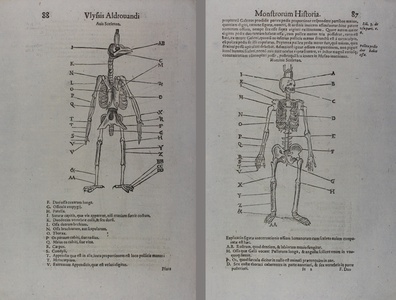| Method | Woodcut |
| Artist | Ulisse Aldrovandi |
| Published | [Bononiae. Typis Nicolai Tebaldini MDCXLII. Superiorum permissu.] |
| Dimensions | Both images 185 x 110 mm, Sheet 350 x 245 mm |
| Notes |
A pair of illustrations, on either side of the same sheet, depicting a human skeleton and a skeleton of a bird, both with a key to their different parts, from the 1642 edition of Aldrovandus' seminal treatise on medical oddities and natural irregularities, the Monstrorum Historia. The Monstrorum Historia is undoubtedly the most famous of Aldrovandus' works, and the seminal text of the history of natural monstrosities and medical aberrations. The illustrations of early editions mostly focussed on medical irregularities, with a particular focus on birth defects and the physical results of disease or injury. The most successful publication, a posthumous edition printed in Bologna by Nicolo Tebaldino in 1642, expanded Aldrovandus' work to include over 300 woodcut illustrations focussing on the full range of monsters, mythical creatures, and medical oddities. Figures of classical and near eastern mythology, such as chimaeras and zoomorphic Egyptian deities, appeared alongside conjoined twins, hermaphroditic figures, and the mythical humanoid creatures which in the Medieval mind dwelled in unexplored regions and the dark corners of the world. In so doing, the work became an amalgam of comparative physiology, medicine, natural history, mythography, antiquarianism, ethnography, and occult theology. Ulisse Aldrovandi (1522-1605), often known simply as Aldrovandus, was a Italian humanist, naturalist, and author, often hailed as the father of modern natural history. A professor of philosophy, logic, and natural history at the University of Bologna, Aldrovandus championed the creation and development of the Orto Botanico di Bologna, one of the oldest botanic gardens in the world. Having studied widely in the humanities, law, philosophy, medicine, logic, zoology, botany, and geology, Aldrovandus was one of the most important scholars in Europe at the end of the sixteenth century. Indeed, Aldrovandus is widely considered to have been the first to use the term 'geology' for this branch of science. His treatises covered many aspects of natural history, and his own collections, housed in a cabinet of curiosities bequeathed to the Senate of Bologna, formed the basis of his monumental Theatrum, an illustrated work of natural history covering more than 7000 specimens demonstrating the diversity of life. Condition: Strong impressions. Minor time toning to edges of sheet. |
| Framing | mounted |
| Price | £150.00 |
| Stock ID | 43819 |

